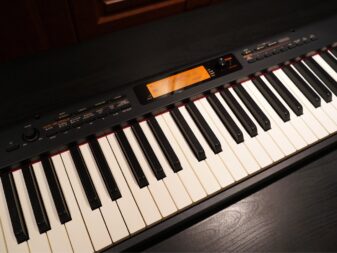 Casio has been making home electronic keyboards for almost four decades now. Although the manufacturer has high-end models, it’s mostly known for beginner-friendly, affordable products. A couple of years ago, I reviewed a flexible and lightweight unit, the CDP-S350. Casio reworked the CDP range and recently released the CDP-S360. This iteration has some upgrades that might interest you, especially if you are a first time buyer. Read on to find out how it sounds, feels and what has been added.
Casio has been making home electronic keyboards for almost four decades now. Although the manufacturer has high-end models, it’s mostly known for beginner-friendly, affordable products. A couple of years ago, I reviewed a flexible and lightweight unit, the CDP-S350. Casio reworked the CDP range and recently released the CDP-S360. This iteration has some upgrades that might interest you, especially if you are a first time buyer. Read on to find out how it sounds, feels and what has been added.
First of all, make sure to check out the short video I filmed featuring the Casio CDP-S360 sounds and my initial impressions.
The piano’s full range in a compact format
The Casio CDP-S360 is an 88 note keyboard, covering the 7+ octaves of the acoustic piano. You’ll also get the feeling of an authentic instrument, thanks to the scaled hammer action. This means the keys are weighted and will present a certain resistance to your hands. It’s really important for beginners, because it helps shape the technique and hand/forearm strength needed when you play on an acoustic model. Experienced players will also feel at home, even though it’s a digital model. This type of action also simulates the differences in resistance between the low and high register. On a normal piano, the keys on the left are heavier than the ones on the right. This comes from the fact that the actual hammers that hit the lower strings are bigger, thus harder to move.
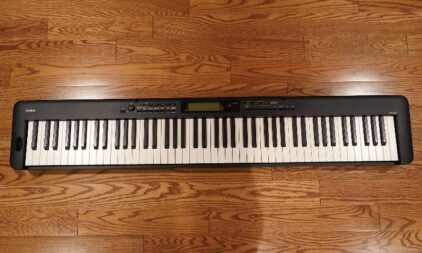
Loads of sounds and options
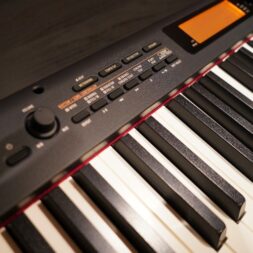 Internally, you get 700 different tones. This includes various pianos and the usual suspects: electric pianos, organs, harpsichords, strings, percussion, brass, and synthesizers. There are also 200 accompaniment rhythms. These are great for practicing, jamming, and writing songs. There is an arranger section to help you with composition and performance. These buttons cue up different song sections like intro, finales, fills, and verse variations.
Internally, you get 700 different tones. This includes various pianos and the usual suspects: electric pianos, organs, harpsichords, strings, percussion, brass, and synthesizers. There are also 200 accompaniment rhythms. These are great for practicing, jamming, and writing songs. There is an arranger section to help you with composition and performance. These buttons cue up different song sections like intro, finales, fills, and verse variations.
The keyboard is shipped with a power adapter, a sustain pedal, and a music stand that inserts on top of the instrument. You can also power it with 6 AA batteries, which is quite convenient for a portable model. There are several connections on the back panel. You’ll be able to plug in an audio device with a 1/8th inch jack to play over the keyboard’s speakers. There’s also a headphone/audio out so you can practice without disturbing the neighbours or amplify your instrument through a PA system. A USB port enables you to connect to a computer for hassle-free MIDI transmission.
Optional Bluetooth
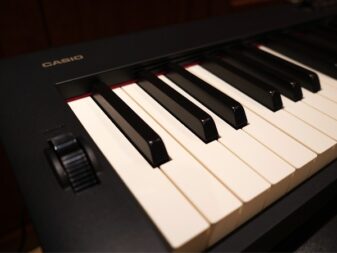 There is also an additional USB port (type A) to plug in an optional WU-BT10 adapter. This product turns your digital piano into a Bluetooth speaker. It can even transmit and receive MIDI from compatible Bluetooth MIDI devices. For players that need to interface with other devices in MIDI, that’s the only way to do it. Speaking of extra accessories, Casio also sells the SP-34, which is a three-pedal unit that adds soft and sostenuto functionality. If you plan on keeping the instrument at home, you can opt for the CS-46 wooden stand or even the CS-470p, which has a triple pedal unit built-in. These optional accessories are Casio’s way of keeping the original price point low; you might not need all of these features. If you do, there’s the availability of an add-on purchase.
There is also an additional USB port (type A) to plug in an optional WU-BT10 adapter. This product turns your digital piano into a Bluetooth speaker. It can even transmit and receive MIDI from compatible Bluetooth MIDI devices. For players that need to interface with other devices in MIDI, that’s the only way to do it. Speaking of extra accessories, Casio also sells the SP-34, which is a three-pedal unit that adds soft and sostenuto functionality. If you plan on keeping the instrument at home, you can opt for the CS-46 wooden stand or even the CS-470p, which has a triple pedal unit built-in. These optional accessories are Casio’s way of keeping the original price point low; you might not need all of these features. If you do, there’s the availability of an add-on purchase.
Upgraded polyphony on the CDP-S360
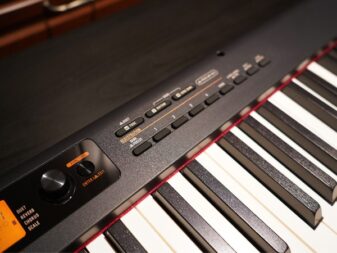 The biggest upgrade on the CDP-S360 from the previous model is the polyphony that goes to 128 (up from 64). This is awesome, because the model can amplify twice as many sounds as before. While we only have 10 fingers, tones are built of many different samples and notes add up with sustain pedals. Essentially, this means that the keyboard can retain its sonic qualities when notes ring into each other and when you play layered tones. You can find out more about polyphony on the blog’s keyboard buying guide.
The biggest upgrade on the CDP-S360 from the previous model is the polyphony that goes to 128 (up from 64). This is awesome, because the model can amplify twice as many sounds as before. While we only have 10 fingers, tones are built of many different samples and notes add up with sustain pedals. Essentially, this means that the keyboard can retain its sonic qualities when notes ring into each other and when you play layered tones. You can find out more about polyphony on the blog’s keyboard buying guide.
The other changes are rather incremental and they include a few modes of playing. First of all, you can split the keyboard down the centre in duet mode. This gives two pianists an equal register to perform or practice together. You can also layer sounds together or split the range into two different sounds. There’s also an octave shift and temperament adjustment, which you might never even use.
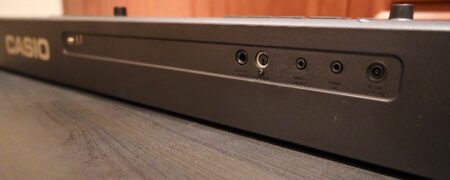
Apart from slightly bigger speakers, that’s pretty much it in terms of improvements. Keep this in mind if you have the previous version. You might find that the changes don’t necessarily warrant an upgrade.
Final thoughts
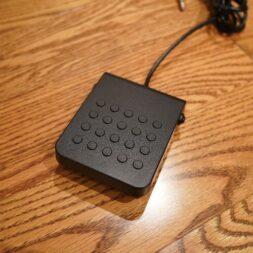 For a relatively inexpensive, full-sized digital keyboard, the CDP-S360 is quite impressive. First of all, the action is balanced, with decent weight, without being too difficult to press. For beginners especially, this is a great starting point. It offers enough resistance to develop technique, but not so that it becomes harder than necessary.
For a relatively inexpensive, full-sized digital keyboard, the CDP-S360 is quite impressive. First of all, the action is balanced, with decent weight, without being too difficult to press. For beginners especially, this is a great starting point. It offers enough resistance to develop technique, but not so that it becomes harder than necessary.
With headphones, the built-in sounds are very good. They offer a lot of detail and their great number provides a lot of variety. Although you might not notice the added polyphony, it actually does help with the richness of the samples and overall quality. This is quite important for playing with the sustain pedal.
The speakers are decent, but their size and their low power make everything sound a bit tinny. It’s not easy to make such a compact keyboard without sacrificing some quality. Thankfully, you can wear headphones or plug into a PA system or keyboard amplifier.
For beginners, the CDP-S360 is a logical choice. It’s affordable, it sounds and feels good and has enough features to keep you occupied for a long time. This is a great model to grow with. It’s also a good choice as a portable keyboard, especially if you only use it for practice. You’ll also have a convenient way of recording your playing on your computer, which is a great way to progress or explore song ideas. That being said, the upgrades (apart from the polyphony) are incremental at best and I don’t think buying up if you already own the CDP-S350 is worth it all that much.
Check out the Casio CDP-S360 digital keyboard on Best Buy’s website.



